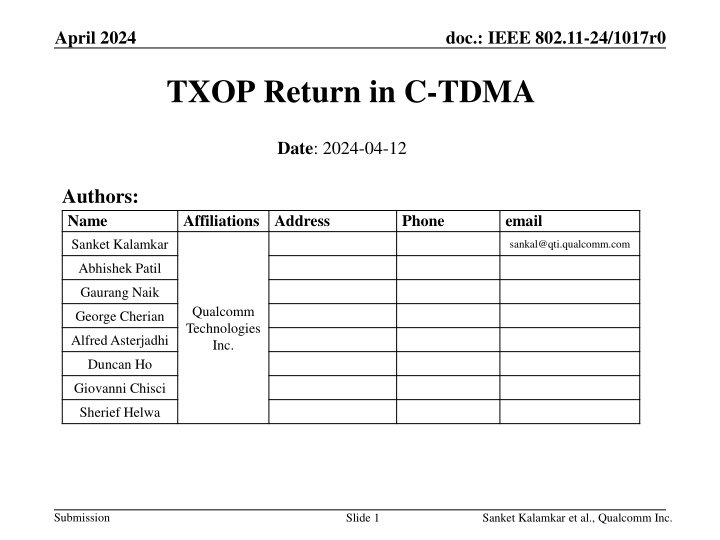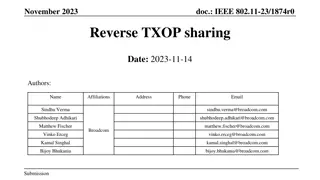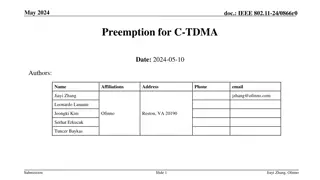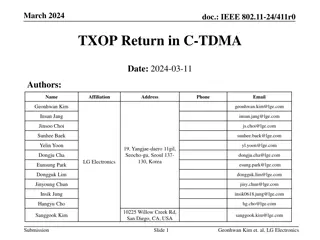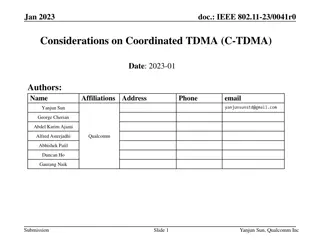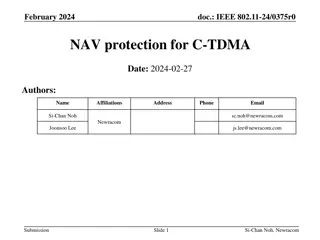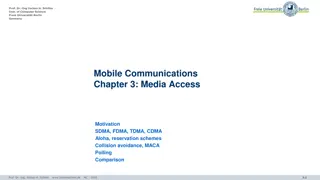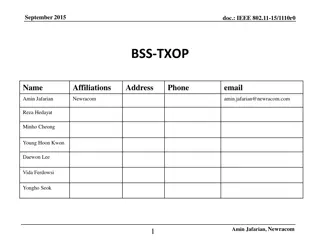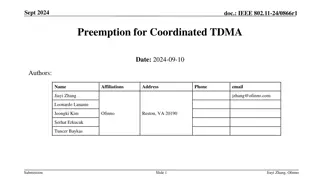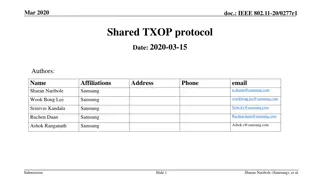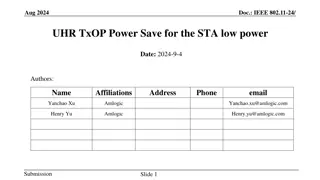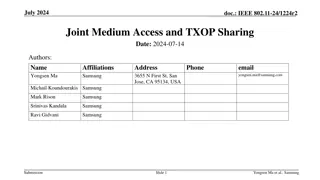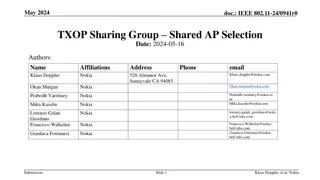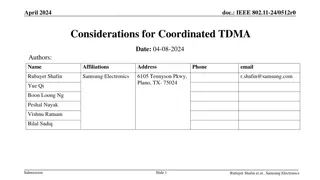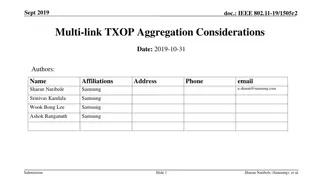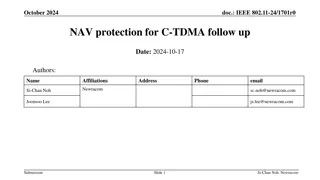IEEE 802.11-24/1017r0 TXOP Return in C-TDMA
IEEE 802.11-24/1017r0 discusses the TXOP return mechanism in C-TDMA, a scheme designed to enhance system efficiency by sharing TXOP time among multiple APs. The document outlines the C-TDMA sequence, challenges with CF-End, and proposes using Public Action frames for TXOP return indication. This mechanism aims to improve latency and reduce contention in wireless networks.
Download Presentation

Please find below an Image/Link to download the presentation.
The content on the website is provided AS IS for your information and personal use only. It may not be sold, licensed, or shared on other websites without obtaining consent from the author.If you encounter any issues during the download, it is possible that the publisher has removed the file from their server.
You are allowed to download the files provided on this website for personal or commercial use, subject to the condition that they are used lawfully. All files are the property of their respective owners.
The content on the website is provided AS IS for your information and personal use only. It may not be sold, licensed, or shared on other websites without obtaining consent from the author.
E N D
Presentation Transcript
April 2024 doc.: IEEE 802.11-24/1017r0 TXOP Return in C-TDMA Date: 2024-04-12 Authors: Name Sanket Kalamkar Affiliations Address Phone email sankal@qti.qualcomm.com Abhishek Patil Gaurang Naik Qualcomm Technologies Inc. George Cherian Alfred Asterjadhi Duncan Ho Giovanni Chisci Sherief Helwa Submission Slide 1 Sanket Kalamkar et al., Qualcomm Inc.
April 2024 doc.: IEEE 802.11-24/1017r0 C-TDMA Background C-TDMA allows an AP that owns a TXOP to share a portion of the TXOP time with one or more APs The scheme is meant to improve latency and improve system efficiencies by reducing contention/collisions C-TDMA Sequence: The sharing AP polls candidate shared APs via a polling/announcement frame The sharing AP triggers TXOP sharing via TXOP Allocation frame The shared AP returns unused TXOP (if any) via TXOP Return frame AP1 Polling/ TXOP Allocation (MU-RTS TXS) Announcement (Sharing AP) STAs of AP1 Frame Exchange(s) between AP1 and its STA(s) Return the TXOP back to AP1 Resp TXOP Return Resp CTS AP2 Frame Exchange(s) between AP2 and its STA(s) (Shared AP) Submission Slide 2 Sanket Kalamkar et al., Qualcomm Inc.
April 2024 doc.: IEEE 802.11-24/1017r0 Mechanism for Returning the TXOP CF-End seemed to be an obvious choice. However: CF-End resets the NAV for all the devices in the neighborhood Intra-BSS NAV is reset for STAs that are 11ax or beyond and belong to the same BSS as the shared AP Basic NAV for pre-11ax STAs or STAs that belong to other BSS Since the NAV is reset for these devices, they can contend to gain access to the medium during the sharing AP s TXOP Can cause the sharing AP to lose control of the TXOP Esp., if the sharing AP is unable to access the medium in SIFS/PIFS after receiving the CF-End TXOP return in TGbe s TXS framework is achieved by means of an indication in the CAS Control field CAS Control field is carried in a QoS Null or a QoS Data frame transmitted by the shared STA to its associated (sharing) AP TGbn C-TDMA could follow the same scheme. However: QoS Null or QoS Data frames cannot be exchanged in unassociated state i.e., between shared and sharing APs Submission Slide 3 Sanket Kalamkar et al., Qualcomm Inc.
April 2024 doc.: IEEE 802.11-24/1017r0 TXOP Return via a Management frame Public Action frames are allowed between unassociated STAs And thus, permitted between sharing and shared APs Carry CAS Control (indicating TXOP return) in a Public Action frame This could be a new frame defined by UHR The proposed frame could also carry other information, such as: Information related to C-TDMA protocol (such as any updates to the C-TDMA parameters) If no additional information is to be carried in the frame body, then the frame can be a null action frame i.e., carries only the MAC header containing the CAS Control field Benefit: Since the information is carried within CAS Control (i.e., header) of a mgmt. frame: It doesn t reset the NAV for neighboring devices Sharing AP can react w/o having to process contents (i.e., the frame body) of the mgmt. frame Consistent with the scheme defined by TGbe TXS framework. Submission Slide 4 Sanket Kalamkar et al., Qualcomm Inc.
April 2024 doc.: IEEE 802.11-24/1017r0 Optionality of TXOP Return TXOP return can be conditional and scenario-dependent For example, when the sharing AP wants to share the TXOP with more than one AP (after the current shared AP) and/or serve in-BSS clients after the shared portion of the TXOP The polling and/or allocation frame could carry an indication of whether TXOP return is requested or not Ability to receive a TXOP return frame could be based on capability of the sharing AP Submission Slide 5 Sanket Kalamkar et al., Qualcomm Inc.
April 2024 doc.: IEEE 802.11-24/1017r0 Summary We identified challenges associated with CF-End as a TXOP return frame in C-TDMA We proposed the use of CAS Control field (indicating TXOP return) in a Public Action frame for returning a shared TXOP Consistent with baseline TXOP return in TXS mechanism Enables sharing AP to maintain control of the TXOP Use of public action frame preserves baseline rules for communication between unassociated STAs. Submission Slide 6 Sanket Kalamkar et al., Qualcomm Inc.
April 2024 doc.: IEEE 802.11-24/1017r0 SP Do you agree that, as part of the C-TDMA procedure, TGbn defines a mechanism for an AP, that receives a portion of the time resource from sharing AP, to return the remainder of the allocated time (if any) back to the sharing AP? Signaling details are TBD. Submission Slide 7 Sanket Kalamkar et al., Qualcomm Inc.
June 2024 doc.: IEEE 802.11-24/1017r0 References [1] Abhishek Patil and et al. , C-TDMA Frame Sequence, 23/1895r1, Jan 2024. [2] Yanjun Sun and et al., Considerations on Coordinated TDMA (C-TDMA), 23/0041r0, Jan 2023. [3] Dibakar Das and et al. , C-TDMA procedure in UHR, 23/0261r0, Apr 2023. [4] Yanjun Sun and et al., Follow-up on Coordinated TDMA (C-TDMA), 23/0739r1, Jul 2023. [5] Si-Chan Noh and et al., Considerations on Return TXOP between multiple APs, 23/1327r0, Aug 2023. [6] Liwen Chu and etc al., Extended TXOP sharing, 23/249r1, May 2023. [7] George Cherian and et al., Coordinated AP Time/Frequency Sharing in a Transmit Opportunity in 11be, 19/1582r2, Nov 2019. [8] Dibakar Das and et al., C-TDMA Follow-up, 23/93r2, Mar. 2024. [9] Geonhwan Kim and et al., TXOP Protection in C-TDMA, 24/227r1, Apr. 2024. [10] Geonhwan Kim and et al., TXOP Return in C-TDMA, 24/411r0, Apr. 2024. [11] Geonhwan Kim and et al., Coordinated TDMA (Follow up), 23/1910r1, Nov. 2023. [12] Si-Chan Noh and et al., NAV protection for C-TDMA, 24/375r0, Feb. 2024. [13] Sanket Kalamkar and et al., NAV Rule in C-TDMA, 24/423r0, May 2024. Slide 8 Submission Sanket Kalamkar et al., Qualcomm Inc.
